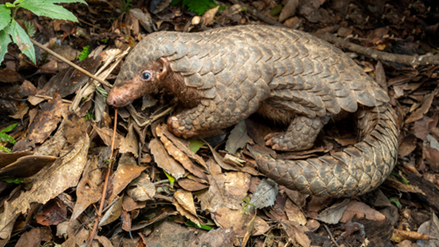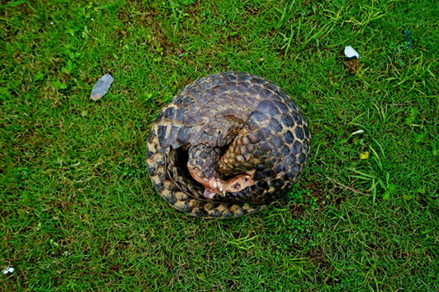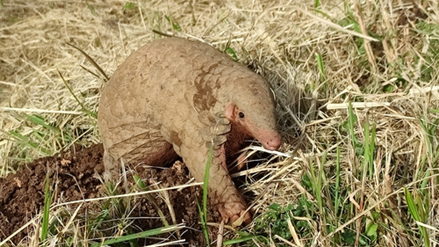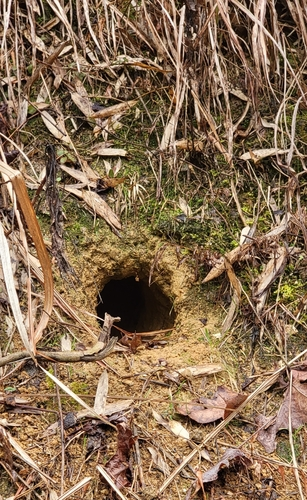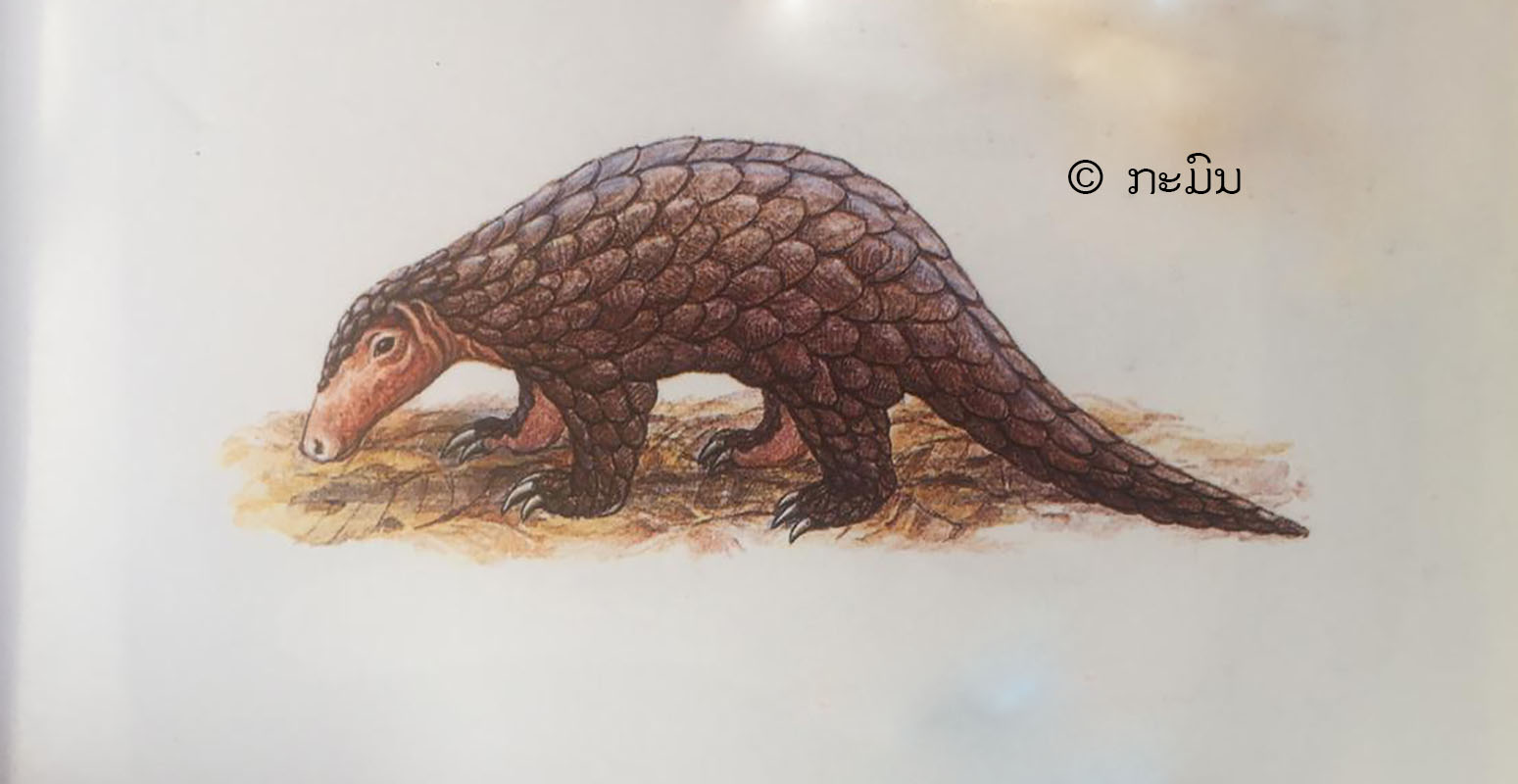ເລກລຳດັບທີ: 3608
ລະດັບການຮວບຮວມຂໍ້ມູນ: ຂໍ້ມູນພື້ນຖານ
ປັບປູງຄັ້ງລ່າສຸດ: 2024-10-19
ລິ່ນງົວ
Chinese Pangolin
Manis pentadactyla Linnaeus, 1758
ສັດ
ສັດລ້ຽງລູກດ້ວຍນົມ
×
ຊື່ທ້ອງຖີ່ນ:
( Short-tailed Pangolin)
ຊື່ພ້ອງ
:
Manis pentadactyla subsp. aurita Hodgson, 1836
Manis pentadactyla subsp. pentadactyla
Manis pentadactyla subsp. pusilla J.Allen, 1906
Manis pentadactyla subsp. pentadactyla
Manis pentadactyla subsp. pusilla J.Allen, 1906
ຊື່ສະກຸນ:
Manidae
ຊະນິດໃກ້ຄຽງ:
ລິ່ນຄວາຍ/ Chinese Pangolin
ບັນຍາຍລັກສະນະທາງພືດສາດ:
ຫົວ ແລະ ລໍາຕົວຍາວ: 40-58 ຊມ. ຫາງຍາວ: 30-38 ຊມ, ເລັບຕີນຫລັງຍາວກວ່າເລັບຕີນໜ້າ 2 ເທົ່າ, ສໍາລັບລັກສະນະນີ້ຍັງຢູ່ໃນການພິຈາລະນາ, ເກັດກາງຫລັງນູນ, ຫາງສັ້ນກວ່າ ແລະ ຮູບຮ່າງສັ້ນ ແລະ ເຕັ້ຍກວ່າລີ່ນຄວາຍ, ຕາມຄວາມຍາວຂອງຫາງຮອດບ່ອນກິ່ວມີ 14-17 ເກັດສ່ວນລິ່ນຄວາຍມີ 28 ເກັດ, ຮອບຕົວມີເກັດ 15-18 ແຖວ ສ່ວນລິ່ນຄວາຍມີ 16-19 ແຖວ. ອຸປະນິໄສ: ເປັນສັດຫາກິນຍາມກາງຄືນ ແລະ ມັກຢູ່ໂດດດ່ຽວ, ອາດຈະມີພຶດຕິກໍາຄືກັນກັບລິນງົວ ແຕ່ວ່າຍັງມີການສຶກສາໜ້ອຍ. ສຽງຮ້ອງ: ? ຖິ່ນອາໄສ: ສ່ວນຫລາຍຢູ່ໃນປ່າເທິງພູ ແລະ ປ່າເທິງພູນ້ອຍ ແລະ ປ່າຊົ່ວຄາວ, ຢູ່ທາງພາກເໜືອບໍລິເວນທີ່ຮາບສູງ ແລະ ພາກໃຕ້ ແຖວລຸ່ມສາຍພູຫລວງໄປຫາແຂວງບໍລິຄໍາໄຊ.
ນິເວດວິທະຍາ
ເຂດກະຈາຍພັນທົ່ວໂລກ:
Bangladesh, Bhutan, China, Hong Kong, India, Lao People's Democratic Republic, Myanmar, Nepal, Taiwan, Province of China, Thailand, Viet Nam.
Global distribution between 2004 to 2024. Source: [6]
Global distribution between 2004 to 2024. Source: [6]
ເຂດກະຈາຍພັນໃນລາວ
:
ເຂດພູສູງພາກເໜືອຂອງລາວ
ເຂດສາຍພູຫຼວງພາກເໜືອ
ເຂດສາຍພູຫຼວງຕອນລຸ່ມ
ເຂດລຽບແມ່ນ້ຳຂອງພາກໃຕ້
ພູພຽງບໍລິເວນ
ເຂດສາຍພູຫຼວງພາກເໜືອ
ເຂດສາຍພູຫຼວງຕອນລຸ່ມ
ເຂດລຽບແມ່ນ້ຳຂອງພາກໃຕ້
ພູພຽງບໍລິເວນ

ເຂດກະຈາຍພັນຕາມພູມສັນຖານ
:
ປ່າໄມ້ປ່ອງ
ປ່າດົງດິບ
ປ່າປະສົມປ່ຽນໃບ
ສວນສາທາລະນະ ແລະ ພື້ນທີ່ສາທາລະນະ
ປ່າດົງດິບ
ປ່າປະສົມປ່ຽນໃບ
ສວນສາທາລະນະ ແລະ ພື້ນທີ່ສາທາລະນະ
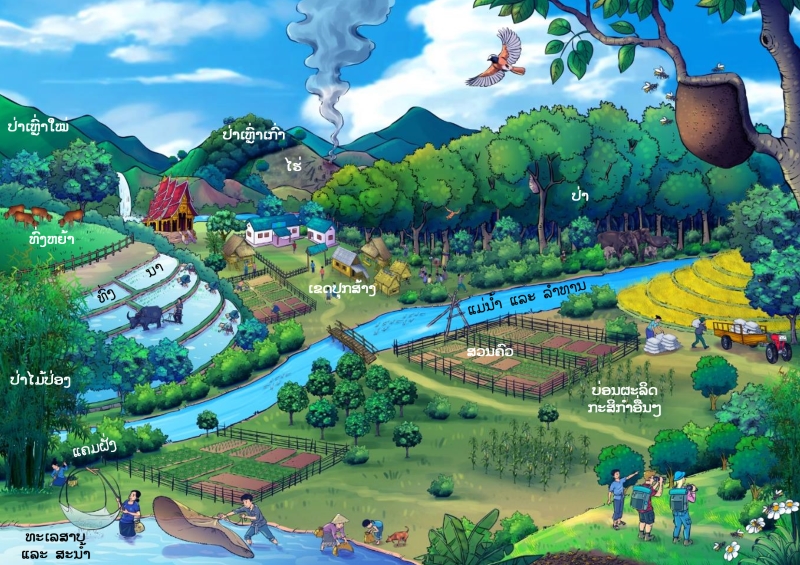
ສະເພາະຖິ່ນໃນລາວ:
ພື້ນເມືອງ
ຮຸກຮານ
:
ບໍ່ຮຸກຮານ
ສະຖານະພາບການອະນູຮັກ IUCN
:
ໃກ້ສູນພັນສູງສຸດ
ສະຖານະພາບການອະນຸຮັກແຫ່ງຊາດລາວ
:
ບັນຊີທີ່ I: ຊະນິດພັນປະເພດຫວງຫ້າມ
ການນຳໃຊ້
ປະເພດການນຳໃຊ້:
ຫ້າມນຳໃຊ້
ບັນຍາຍການນຳໃຊ້:
ການປູກ ການລ້ຽງ:
ຊະນິດທຳມະຊາດ
ລະດູການເກັບກູ້:
ກຸມພາ
ມີນາ
ເມສາ
ພຶກສະພາ
ມິຖຸນາ
ກໍລະກົດ
ມີນາ
ເມສາ
ພຶກສະພາ
ມິຖຸນາ
ກໍລະກົດ
ການຕະຫຼາດ ແລະ ຕ່ອງໂສ້ມູນຄ່າ:
N/A
ການຄຸ້ມຄອງຈັດການ
N/A
ໂພຊະນາການ
ຄຸນຄ່າທາງໂພຊະນາການ:
ບັນຍາຍຄຸນຄ່າທາງໂພຊະນາການ:
N/A
| ສານອາຫານ | /100g | ໝາຍເຫດ |
|---|---|---|
| ໂປຣຕີນ | N/A | N/A |
| ຄາໂບໄຮເດຣດ | N/A | N/A |
| ໄຂມັນ | N/A | N/A |
| ວິຕາມິນ | N/A | N/A |
| ແຮ່ທາດ | N/A | N/A |
| ເສັ້ນໄຍ | N/A | N/A |
ອ້າງອິງ
ເຄດິດຮູບພາບ:
Chinese pangolin. [1] iNaturalist [Online]. Uploaded in June 2023 by: ededwarddd. Available: www.inaturalist.org/photos/296250377. [Accessed: 04 October 2024].
Chinese Pangolin curled up. [2] iNaturalist [Online]. Uploaded in July 2021 by: copyboy. Available: www.inaturalist.org/photos/145800726. [Accessed: 04 October 2024].
Bigger Chinese Pangolin. [3] iNaturalist [Online]. Uploaded in January 2023 by: carson18. Available: www.inaturalist.org/photos/340291006. [Accessed: 04 October 2024].
Hole in which the Chinese Pangolin lives. [4] iNaturalist [Online]. Uploaded in January 2023 by: amarzee. Available: www.inaturalist.org/photos/253352896. [Accessed: 04 October 2024].
Chinese Pangolin curled up. [2] iNaturalist [Online]. Uploaded in July 2021 by: copyboy. Available: www.inaturalist.org/photos/145800726. [Accessed: 04 October 2024].
Bigger Chinese Pangolin. [3] iNaturalist [Online]. Uploaded in January 2023 by: carson18. Available: www.inaturalist.org/photos/340291006. [Accessed: 04 October 2024].
Hole in which the Chinese Pangolin lives. [4] iNaturalist [Online]. Uploaded in January 2023 by: amarzee. Available: www.inaturalist.org/photos/253352896. [Accessed: 04 October 2024].
ອ້າງອິງ:
[5] D. Prathumthong and A. Khlaipet, "Mammals of Nature World Heritage Thong Yai Naresuan-Huai Kha Khaeng," National Science Museum Thailand, Thani Province, Thailand, 2022.
[6] Global Biodiversity Information Facility (GBIF), “Manis pentadactyla Linnaeus, 1758” [Online]. Available: https://www.gbif.org/species/5219638. [Accessed: 04 October 2024].
[7] IUCN Red List, “Manis pentadactyla Linnaeus, 1758,” [Online]. Available: https://www.iucnredlist.org/species/12764/168392151#conservation-actions. [Accessed: 09 August 2024].
[8] P. A. Thapa, "An Overview of Chinese Pangolin (Manis)," [Online]. Available: https://d1wqtxts1xzle7.cloudfront.net/105839771/8346-libre.pdf?1695221496=&response-content-disposition=inline%3B+filename%3DAn_Overview_of_Chinese_Pangolin_Manis_pe.pdf&Expires=1723452502&Signature=SfaMFMGtEp~QJAniTPtz1Sq6f-TMaTg7vWT8nrjJyKx12ko~BT6kl8wk. [Accessed: 12 August 2024].
[6] Global Biodiversity Information Facility (GBIF), “Manis pentadactyla Linnaeus, 1758” [Online]. Available: https://www.gbif.org/species/5219638. [Accessed: 04 October 2024].
[7] IUCN Red List, “Manis pentadactyla Linnaeus, 1758,” [Online]. Available: https://www.iucnredlist.org/species/12764/168392151#conservation-actions. [Accessed: 09 August 2024].
[8] P. A. Thapa, "An Overview of Chinese Pangolin (Manis)," [Online]. Available: https://d1wqtxts1xzle7.cloudfront.net/105839771/8346-libre.pdf?1695221496=&response-content-disposition=inline%3B+filename%3DAn_Overview_of_Chinese_Pangolin_Manis_pe.pdf&Expires=1723452502&Signature=SfaMFMGtEp~QJAniTPtz1Sq6f-TMaTg7vWT8nrjJyKx12ko~BT6kl8wk. [Accessed: 12 August 2024].
ຜູ້ສ້າງ Factsheet:
ຜູ້ກວດສອບ Factsheet:
,
